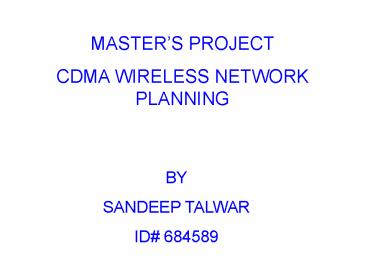MASTERS PROJECT - PowerPoint PPT Presentation
1 / 25
Title:
MASTERS PROJECT
Description:
AVERAGE VOICE PACKET END-TO-END DELAY. AVERAGE VOICE PACKET DELAY VARIATION ... Looking at the network end to end, its performance is dictated by the load on ... – PowerPoint PPT presentation
Number of Views:19
Avg rating:3.0/5.0
Title: MASTERS PROJECT
1
MASTERS PROJECT CDMA WIRELESS NETWORK PLANNING
BY SANDEEP TALWAR ID 684589
2
- CDMA
- WIRELESS NETWORK
- NETWORK PLANNING
3
(No Transcript)
4
- TWO SCENARIOS IN CELLULAR SYSTEM
- HANDOFF
- FREQUENCY REUSE
5
LAYOUT OF CELLULAR COMMUNICATION SYSTEM
- SWITCHING SYSTEMS
- DATA BASED SYSTEMS
- RADIO SYSTEMS
- EXTERNAL NETWORKS
6
(No Transcript)
7
- SWITCHING SYSTEM
- MOBILE SWITCHING CENTER
- GATEWAY MOBILE SWITCHING CENTER
- DATA BASED SYSTEM
- HOME LOCATION REGISTER (HLR)
- VISITOR LOCATION REGISTER (VLR)
- EQUIPMENT IDENTITY REGISTER
- AUTHENTICATION CENTER
- RADIO SYSTEM
- BASE STATION CONTROLLER
- BASE TRANSCEIVER SYSTEM
- EXTERNAL NETWORKS
- PUBLIC SWITCH TELEPHONE NETWORK
- INTEGRATED SERVICE DIGITAL NETWORK
8
- MULTIPLE ACCESS TECHNOLOGIES
- FDMA
- TDMA
- SSMA
- 1. CDMA
- 2. FHMA
- 3. SDMA
9
RF PLANNING
- ANTENNA SYSTEMS
- RF PROPOGATION
- FREQUENCY PLANNING
- TRAFFIC PLANNING
10
- ANTENNA SYSTEMS
- WIRE ANTENNAS
- APERTURE ANTENNAS
- ANTENNA ARRAYS
- PARABOLIC REFLECTOR
11
- 2. RF PROPOGATION
- FREE SPACE PROPOGATION
- PROPOGATION OBSTRUCTIONS
- PROPOGATION MODES
- FADING MULTIPATH EFFECTS
12
- 3. FREQUENCY PLANNING
- INTERFERENCE VS NOISE
- REUSE EFFECIENCY INTERFERENCE
13
- 4. TRAFFIC PLANNING
- BASIC TRAFFIC UNITS
- GRADE OF SERVICE
- THE BUSY HOUR
- OFFERED CARRIED TRAFFIC
- LOSS SYSTEMS VS DELAYED SYSTEMS
14
- OPTIMIZATION QUALITY OF SERVICE (QoS) IN
WIRELESS NETWORKS - OPTIMIZATION TECHNIQUES
- DOWNTILTING
- POWER SYSTEMS
- CHANGE ANTENNAS
- ADJUST ANTENNA RADIATION CENTER LINE
- NEED A REPEATER
- HANDOFF ADJUSTMENTS
15
OPNET SIMULATION FOR FACTORS INFLUENCING QUALITY
OF SERVICE IN NEXT GENERATION NETWORK
CBR vs. VBR Four applications considered in this
work are E-mail, FTP, Web browsing (HTTP), and
Voice over IP. Voice over IP is simulated as
constant-bit-rate (CBR) traffic, while the
remaining three, as variable-bit-rate (VBR)
traffic. Distribution function of source
applications Distribution function of source
applications refers to probability distribution
function of various parameters such as file size
and inter-arrival time. In this work, we have
only varied file size, keeping other parameters
constant. End-to-end delay and Delay Variation
for VoIP traffic End-to-end delay for a voice
packet is measured from the time it is created by
the called party to the time it is received by
the calling party the delay variation is the
variance computed from the end-to-end delays for
voice packets. Gateway GPRS Support Node
(GGSN) GGSN is the interface toward the external
IP packet networks.
16
General Packet Radio Service (GPRS) GPRS is a
packet switched service, which enhances the GSM
network functionality providing full mobility and
wide area coverage. The GPRS system provides a
solution for Internet Protocol (IP) communication
between Mobile Stations (MS) and Internet Service
Hosts or a corporate LAN. Quality of Service
(QoS) The term QoS can be defined as the
collective effect of service performances, which
determine the degree of satisfaction of a user of
the service. In this work, the term QoS refers
to the set of performance parameters that can be
directly observed and measured at the point at
which the user accesses the service. The term
QoS management is used to denote the
operational means of differentiating packet
flows, based on their service needs. Serving
GPRS Support Node (SGSN) SGSN forwards incoming
and outgoing IP packets addressed to/from a
mobile station (MS) that is attached within the
SGSN service area. Traffic Shaping This
function 'shapes' or smoothes the traffic to
reduce any adverse impact on the network. The
packets are first buffered and then transmitted
at a smoothed, more regular rate. The algorithm
used in the simulator is the 'leaky bucket
algorithm'.
17
DESCRIPTION OF MODEL GPRS END-TO-END NETWORK
18
COMPARISON OF TRAFFIC PROFILES
19
AVERAGE VOICE PACKET END-TO-END DELAY
20
AVERAGE VOICE PACKET DELAY VARIATION
21
VOICE PACKET DELAY AT LOW UTILIZATION
22
VOICE PACKET END-TO-END DELAY IN GPRS
23
EFFECT OF SHAPING ON VOICE PACKET DELAY VARIATION
24
- CONCLUSIONS
- In a network carrying both CBR and VBR traffic,
the mean delay of CBR traffic is independent of
types of distribution functions describing VBR
traffic. - Delay variation experienced by the CBR traffic is
proportional to the burstiness of the VBR
traffic. - Presence of traffic shaping mechanisms
considerably reduces the delay variation of CBR
traffic. - Looking at the network end to end, its
performance is dictated by the load on the
weakest link in the network. - There is always improvement in performance such
as delay as a result of instituting QoS
management in a network.
25
THANK YOU































